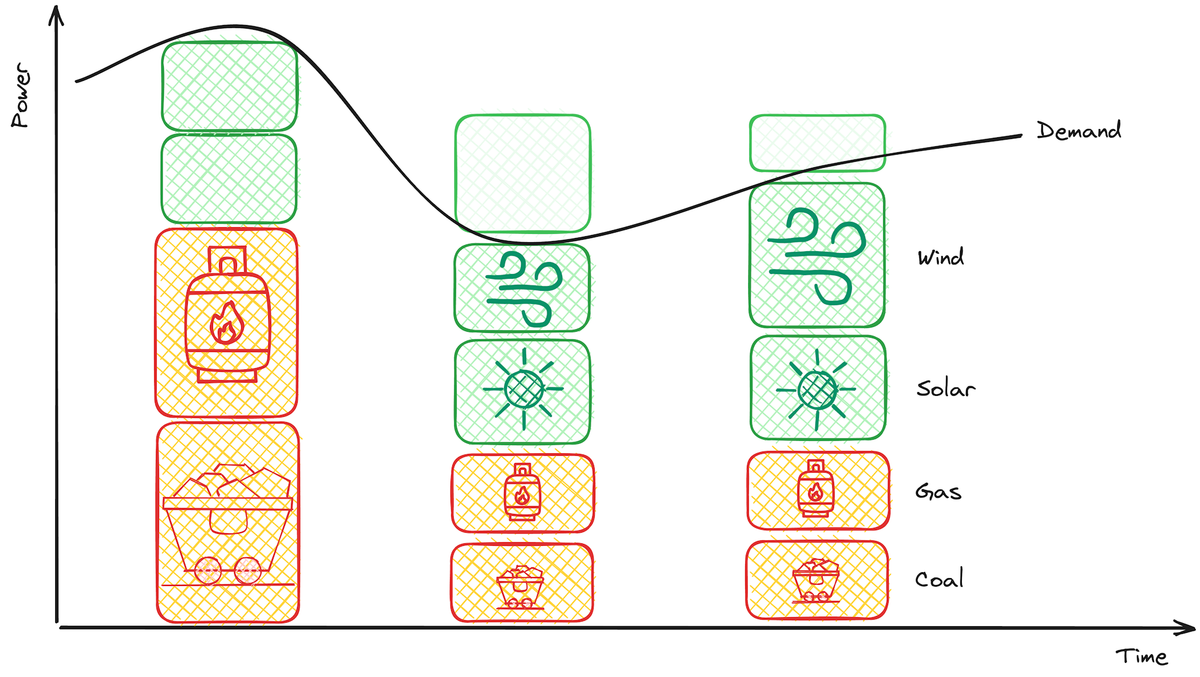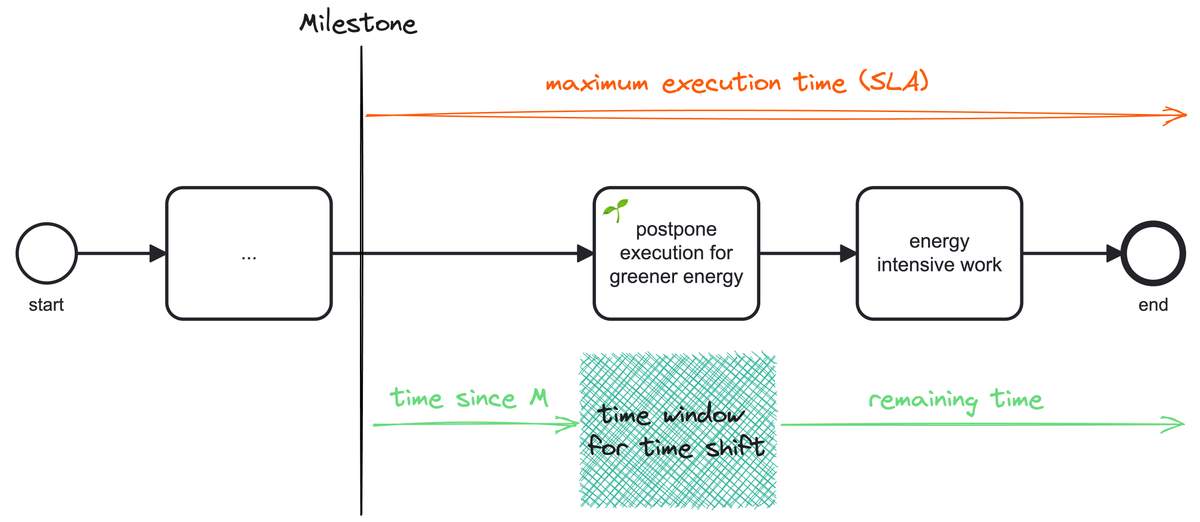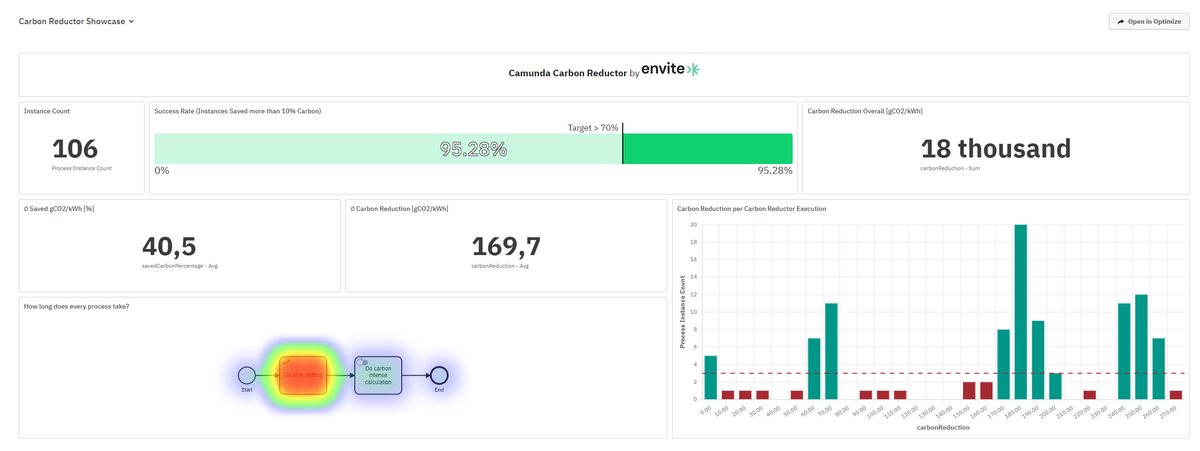
Camunda Carbon Reductor
The Camunda Carbon Reductor allows you to time shift your business process execution to a time when energy is green.
Business processes are often automated using a process engine such as Camunda. The Camunda Carbon Reductor mitigates your processes' carbon footprint by time shifting energy intensive tasks. This concept is applied by placing a Carbon Reductor modeling element before an energy intensive task managed by the Camunda Process Engine. Whenever the execution of a process reaches this element the Carbon Reductor takes charge, assessing whether carbon savings can be achieved by postponing the execution of the remaining tasks to a later time or if it should be executed right away.
Marginal Carbon Intensity
The time window for the time shift is determined by taking into account the forecast of the marginal carbon intensity. To understand this concept, you have to realize that in power grids, it is essential to maintain a constant balance between supply and demand. When there is a sudden need for more power, it must be supplied by an active power station. The marginal carbon intensity represents the carbon emissions of the power plant that would need to be activated to meet the increased demand. Fossil fuel-based power plants can seldom be completely shut down; they have a minimum operating threshold, and some are inflexible, essentially serving as a constant and always available baseline power source. Consequently, there are situations in which we may restrict or even discard renewable energy while still relying on energy generated from fossil fuel power plants (shown in the figure below). In such cases, the marginal carbon intensity is zero grams of CO2 equivalent per kilowatt-hour (gCO2eq/kWh) because any new demand can be met with the renewable energy sources that we have been limiting up to this time. This is the fundamental principle on which the Camunda Carbon Reductor operates.

Calculating the Time Shift Windows
The Carbon Reductor is utilizing tools such as the carbon-aware-sdk, with for example WattTime serving as the data provider which provides a forecast of the marginal carbon intensity. To make use of the carbon-aware-sdk’s API, you must provide the following information:
- the geographical region in which the process is being executed,
- the start time of the process instance,
- the maximum allowable runtime until the process instance’s completion (SLA),
- and the duration of the remaining activities.
The specification of the region is crucial, as it enables the system to generate relevant energy forecasts, taking into account regional variations in power grids. The remaining activities' duration, in conjunction with the process start time and the maximum runtime, is utilized to establish a time window for potential postponements, ensuring compliance with the maximum runtime SLA. The next figure illustrates the calculation.

Visualizing the Saved Carbon
The Camunda Carbon Reductor not only facilitates the time-shifting of process execution but also enables the tracking and reporting of the reduction in carbon emissions achieved. When integrated with Camunda Optimize (the monitoring tool offered by Camunda) you can generate dashboards showcasing the effectiveness of the Carbon Reductor. This, in turn, enhances visibility of your sustainability efforts and their positive impact as shown in the next screenshot.

For more in-depth information regarding the implementation of the Carbon Reductor, we encourage you to explore our blog post on the Camunda blog or take a closer look at our GitHub repository.
Resources
- Camunda Blog - The Camunda 8 Connector for Carbon-Aware Process Execution
- GitHub - Camunda Carbon Reductor
- GitHub - Carbon Aware SDK
About the authors

Luc Weinbrecht is Green BPM Consultant at envite. As a Camunda Champion, he enthusiastically works on modern software architecture in the context of Camunda and the design of new opportunities and solutions for business monitoring.
Find Luc on luc-weinbrecht
Philipp Hehnle is Green BPM Consultant at envite. He brings his knowledge as a Camunda Champion to support his customers digitizing their business processes using Camunda. He focuses on the environmental impacts of the workflows and how to reduce them. Furthermore, he works on the challenge to digitize efficiently and reuse similar business processes.
Find Philipp on philipp-hehnle
Maximilian Behrendt is Green BPM Consultant at envite. He has been working on the automation of business processes in numerous customer projects for several years. In addition to the technical implementation in the backend, he always focuses on the interaction with the business modeling and the business value.
Find Maximilian on maximilian-behrendt-tueEnjoy these
Foundational basic Patterns
Combine small activities into composite activities
Eliminate unnecessary activities
Buffer external information and subscribe to updates
Empower workers for more decision-making authority
Let customers interact with the company wherever they want to
Assign tasks based on resources' roles in the organisation
Experience-based task assignment
Delegate task according to experience: execution frequency, case involvement, interactions
Delegate tasks according to resource cost
Distribute tasks by interdepartmental interactions to enable or restrict involvement